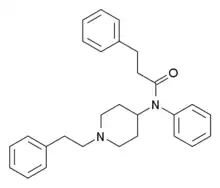3-Phenylpropanoylfentanyl
 | |
| Legal status | |
|---|---|
| Legal status |
|
| Identifiers | |
IUPAC name
| |
| CAS Number | |
| UNII | |
| Chemical and physical data | |
| Formula | C28H32N2O |
| Molar mass | 412.577 g·mol−1 |
| 3D model (JSmol) | |
SMILES
| |
3-Phenylpropanoylfentanyl (β'-phenylfentanyl) is an opioid analgesic that is an analog of fentanyl, which was invented in 1981,[2] and has been sold as a designer drug, first identified in March 2017 in Sweden.[3]
Side effects
Side effects of fentanyl analogs are similar to those of fentanyl itself, which include itching, nausea and potentially serious respiratory depression, which can be life-threatening. Fentanyl analogs have killed hundreds of people throughout Europe and the former Soviet republics since the most recent resurgence in use began in Estonia in the early 2000s, and novel derivatives continue to appear.[4] A new wave of fentanyl analogues and associated deaths began in around 2014 in the US, and have continued to grow in prevalence. Since 2016 these drugs have been responsible for hundreds of overdose deaths every week.[5]
Legal status
3-Phenylpropanoylfentanyl was banned in Finland in September 2017,[6] and in Sweden in October 2017.[7] It was also banned in Lithuania in 2017.[8] Banned in United States on April 27th 2021 (schedule 1 of the Controlled Substances Act).[9]
See also
References
- ↑ Drug Enforcement Administration, Department of Justice (2018). "Schedules of Controlled Substances:Temporary Placement of Fentanyl-Related Substances in Schedule I. Temporary amendment; temporary scheduling order". Federal Register. 83 (25): 5188–92. PMID 29932611.
- ↑ Zhu YQ, Ge GL, Fang SN, Zhu YC, Dai QY, Tan ZY, Huang ZM, Chen XJ (March 1981). "[Studies on potent analgesics. I. Synthesis and analgesic activity of derivatives of fentanyl (author's transl)]". Yao Xue Xue Bao = Acta Pharmaceutica Sinica. 16 (3): 199–210. PMID 6264735.
- ↑ "Neue psychoaktive Subst. - Fentanylderivate" [New psychoactive substances - fentanyl derivatives]. European Union Early Warning System (in German). 1 June 2017.
- ↑ Mounteney J, Giraudon I, Denissov G, Griffiths P (July 2015). "Fentanyls: Are we missing the signs? Highly potent and on the rise in Europe". The International Journal on Drug Policy. 26 (7): 626–31. doi:10.1016/j.drugpo.2015.04.003. PMID 25976511.
- ↑ Armenian P, Vo KT, Barr-Walker J, Lynch KL (October 2017). "Fentanyl, fentanyl analogs and novel synthetic opioids: A comprehensive review" (PDF). Neuropharmacology. 134 (Pt A): 121–132. doi:10.1016/j.neuropharm.2017.10.016. PMID 29042317. S2CID 21404877.
- ↑ "Government Decree amending Annex IV to the Government Decree on substances, preparations and plants to be classified as narcotics". Notification detail. European Commission. 12 September 2017.
The following 9 new substances are classified: 4-chloro-isobutyrfentanyl, 4-Fluoro-isobutyrfentanyl, 3-phenylpropanoylfentanyl, benzodioxole fentanyl, benzoyl fentanyl, cyclopentyl fentanyl, cyclopropyl fentanyl, methoxyacetyl fentanyl and tetramethylcyclopropyane fentanyl.
- ↑ "14 nya ämnen kan klassas som narkotika eller hälsofarlig vara" [14 new substances can be classified as drugs or health hazards] (in Swedish). The Public Health Agency of Sweden. 14 October 2017.
- ↑ "dėl narkotinių ir psichotropinių medžiagų nedidelio, didelio ir labai didelio kiekio nustatymo" [On the future, large and very large quality of drugs and phytotropic matters] (in Lithuanian). 1Respublikos Sveikatos Apsaugos Ministro [Ministry of Health Protection of the Republic]. 2003.
- ↑ "Import/Export Restrictions Finalized on Opioids". ST&R Sandler, Travis & Rosenberg, P.A. 2021.